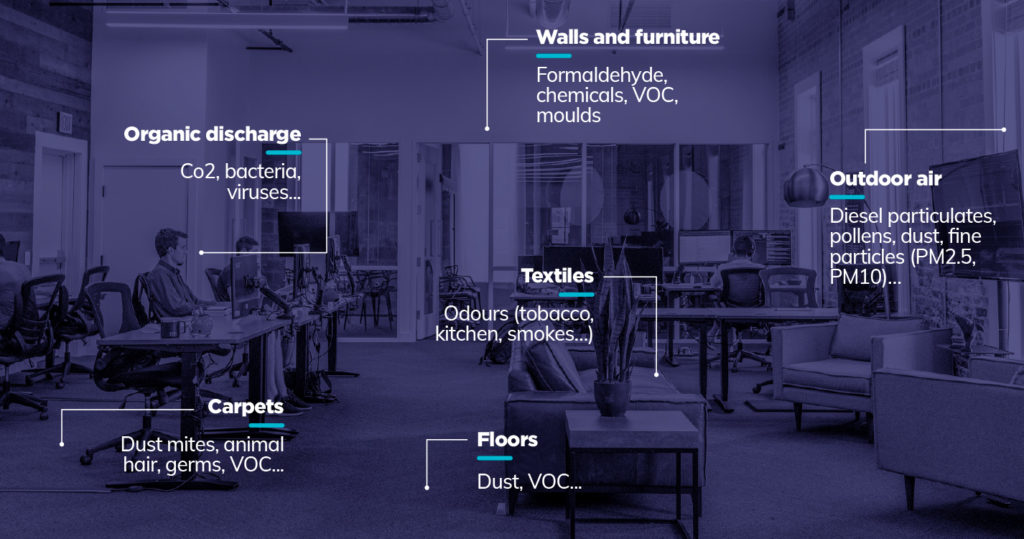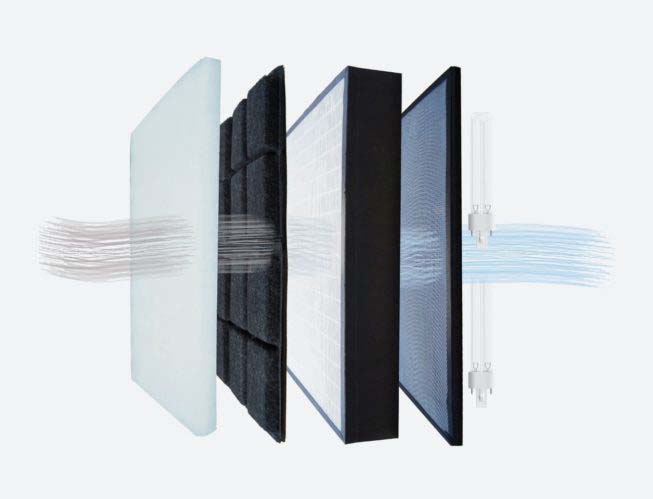05/09/2024


30 December 2020
With the Covid 19 pandemic, indoor air quality has become an even more preoccupying public safety issue. When a domestic air purifier has a main action on pollens, a professional device aims at treating all pollutants and chimical, physical and organic pollutant targets, including viruses, thanks to a combination of prefilter, activated carbon, HEPA H13 filter, UV-C lamps and oxydation filter, such as EOLIS Air Manager from NatéoSanté, which efficacy at 99.6% against coronaviruses has been tested and proved in an independent laboratory.
An air purifier not only removes pollen grains and unpleasant odours but also the whole range of pollutants and/or particles present in indoor air. Air that has been absorbed and processed by the purifier is then released as purified air into the room or premises where it is located.
There are two types of air purifier: domestic and professional, including devices suitable for use in medical settings, whose differences in terms of overall performance and components used (specifically filters) are reflected in the price.
Lastly, an air purifier must not itself produce pollutants: the device must be safe to use. This is one of the exclusive features of the EOLIS Air Manager from NatéoSanté.
 The different sources of pollution potentially present in indoor air
The different sources of pollution potentially present in indoor air
The three main sources of indoor air pollution targeted by professional air purifiers with the aim of removing them are:
• Chemical pollution: gases and VOCs, or Volatile Organic Compounds
These are the compounds present in:
Amongst the VOCs and gases most commonly found are:
• Physical pollution: micro and nano-particles from PM 10 to PM 0.1
The main sources of particles present in indoor air are:
• Biological pollution: micro-organisms
The main micro-organisms found in indoor air are:
All of the above pollutants have a direct and negative impact on human health. They are all dealt simultaneously by the EOLIS Air Manager.
An unpleasant smell, such as solvent in glue, is often the first sign that indoor air is polluted. But viruses and nano-particles have no smell!
There’s a different solution and a different technique for each individual pollutant, which has to be dealt with in a particular way:
Pollutants
Solutions
The EOLIS Air Manager professional air purifier from NatéoSanté operates in four main stages.
• Stage 1: pre-filter
Polluted air passes through a removable pre-filter which captures the largest dust particles. The filter’s surface is coated with a biocide which destroys mites, bacteria, viruses and spores on contact
- The bactericidal, virucidal and acaricidal pre-filter used in the EOLIS Air Manager is certified according to standards ISO 18184:2019 and NF G39-011
• Stage 2: activated carbon
Very high density activated carbon is used in the EOLIS Air Manager because it can absorb chemical pollutants such as gases!
• Stage 3: HEPA filter
The purpose of a HEPA filter is to capture fine particles. HEPA filters act like a sieve. The H13 filter in the EOLIS Air Manager is individually tested and certified and is effective against 99.97% of particles and viruses of 0.1 µm (99.99% of those up to 0.3 µm). The optional ULPA U15 filter removes up to 99.97% of particles of 0.1 µm.
The Covid-19 virus varies from 0.1 to 0.15 µm.
 Illustration of the Eolis Air Manager certified filtration system
Illustration of the Eolis Air Manager certified filtration system
Stage 4: oxydation / UV-C lamps
Generally speaking, oxydation consists in breaking down a substance using light rays on the surface of a catalyst. The UV-C rays oxidise and destroy pollutants absorbed on the surface of the oxydation grid.
The EOLIS Air Manager air purifier is fitted with an oxydation honeycomb grid coated with TiO2.
UV-C lamps activate the catalyst so that the pollutants break down, mainly into C02 and H20.
It’s important to be clear about your requirements as a professional user.
• What kind of pollutants do I need to deal with in my professional activity?
The kind of pollutants you encounter will inform your choice of the right filtration technologies.
• What are the quantities of pollutants and what is the size of the premises?
These criteria will decide the capacity of the most suitable professional air purifier, including its air flow.
It’s one of several factors affecting your choice. It depends on your business and which pollutants you need to deal with. In a hairdresser’s salon, a high-volume air purifier without activated carbon will be of little use. The length of contact time on the activated carbon and the oxydation grid, and whether or not there are germicidal UV-C lamps, are just as important as airflow alone.
This is what makes the EOLIS Air Manager a technologically complete appliance that is versatile enough to be used in every professional setting.
A domestic device is designed to provide comfortable air quality mainly by removing pollen.
A professional indoor air purifier like the EOLIS Air Manager from NatéoSanté offers direct health benefits by acting both as prevention and cure. In workplaces that are particularly exposed to risks, such as a hair salon or podiatry clinic, it is effective in getting rid of chemical fumes arising from hair colourants and neoprene glues.
In the context of Covid-19, in both medical and para-medical settings, in hotels and restaurants, and in offices and open-plan work spaces, not only are the EOLIS Air Manager’s filters designed to work on virus-sized particles, but it also offers further chemical techniques to destroy them.
BUSINESSES: why buy
a professional air purifier?
There is total transparency for the user: measurements and data guarantee its performance. A patented process allows for clogging of the filter to be monitored continuously. When the filter is clogged, the EOLIS Air Manager stops working until a new filter is fitted, to avoid giving the false impression that it is still purifying the air.
EOLIS Air Manager professional air purifier has been tested in September 2020 by an independent reference laboratory, specialist in microbiology. It has proved its efficacy at 99.6% against coronaviruses, after only 10 minutes of operation, at low speed. The tested device was a standard EOLIS Air Manager 600, equipped with a Perform+ block filter which includes a HEPA 13 filter, certified according to the NF EN ISO 29463-4 standard.
see the complete report on the test and methodology